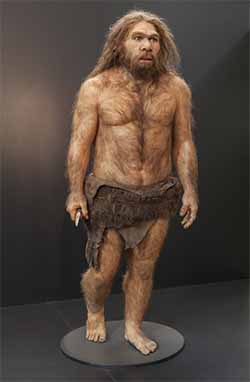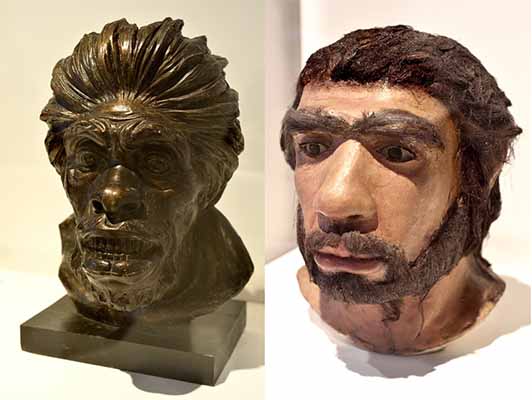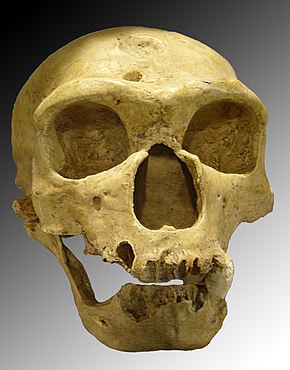Why Did Neanderthals Go Extinct Some 28,000 Years Ago ?
An In-depth Look At The Wild Man

The last Neanderthals
About 40,000 years ago, the European continent was home to another species of hominid at a time when modern humans first set foot there. The Neanderthals had been there for hundreds of thousands of years; so long that evolution into a distinct species has not yet occurred in our ancestral cradle, Africa. According to archaeological findings, the two humanoid species shared the vast territory of Europe for nearly 10,000 years before Neanderthals disappeared abruptly. The last Neanderthals left traces in the caves of Gibraltar almost 28,000 years ago. Neanderthal extinction has made modern man the last surviving human species. The question that arises is why did Neanderthals die out ?
The Neanderthal man

Neanderthal man is often presented as the very archetype of the wild man. He lives in caves, goes hunting and fishing, has a slow mind and communicates only with guttural grunts. He has entangled hair and a grossly neglected beard. He is often depicted vaulted, bearing a club and dressed with animal skins singularly sewn. His name has even become synonymous with barbarian. However, archaeological research has shown that this portrait does not correspond to reality. Neanderthal mans would have been monogamous and would have lived in separate small groups. They were very similar to modern man in many of their rituals; especially in the way they buried the dead and cared for their sick and wounded neighbors. Despite the fact that they communicated in a very primary way, the Neanderthals were great hunters and craftsmen and some traces found on Mediterranean islands testify to their ability to travel in open water. This indicates that some boat building techniques were known a very long time ago. Neanderthal man great artistic talent is confirmed by several cave paintings which some dates as far back as about 42,000 years ago.
Neanderthals vs humans

There are, however, enormous anatomical differences between Neanderthals and modern humans. The differences are mainly in the cranial box; inclined forehead and prominent eyebrows. Their chin was also much less prominent than us. Having lived in the cold climate of Europe, they were much better adapted, as their small sturdy stature suggests. Homo sapiens, which has evolved in the heat of the African savannah, is thinner and less stocky. But despite these notable differences, it would be difficult to distinguish Neanderthal man from modern man if the former was to cut off his hair and dress with a pair of jeans and a shirt.

In addition to physiological differences, there were also cultural differences between Neanderthals and humans. The Neanderthals had a rather antisocial behavior; they formed small groups and had very little contact with individuals outside their circle. This characteristic of the wild man would probably not go unnoticed in the modern era in which we are. Another interesting distinction is found in the stone tools used by Homo neanderthalensis and Homo sapiens. The Mousterian name is given to Neanderthalian tools, which barely evolved over hundreds of millennia and betray the lack of adaptation of this now extinct species. It seems that unlike humans, Neanderthals were incapable of ingenuity or problem solving.
Neanderthal evolution
Although it is impossible at the present time to say so with certainty, several archaeological discoveries indicate that Neanderthal man forked 400,000 years ago from the line of evolution that led to modern man. The common ancestor would be Homo heidelbergensis, himself a descendant of Homo erectus. A group of Homo heidelbergensis apparently crossed over the European continent before being detached from the original population following a long period of glaciation. The radically different climatic conditions of the African and European continent would have given birth to two types of humanoid some 150,000 years ago. Neanderthals would have dispersed to Asia and in the Middle East while modern humans began to leave Africa nearly 70,000 years ago.  According to all indications, there has been very little contact between the two lines of evolution. The Neanderthals population gradually shrank over the millennia until only a few small surviving groups found themselves isolated in the caves of the Rock of Gibraltar. Possible causes of extinction includes the spread of diseases and the confrontation and competition for the same resources with Homo sapiens. History tends to blame modern man, who has wreaked havoc everywhere he has colonized. He has eroded forests, decimated faunas and wiped out many indigenous peoples. It may be thought that a combination of these different factors contributed greatly to Neanderthal extinction, although there is no evidence to support these assumptions.
According to all indications, there has been very little contact between the two lines of evolution. The Neanderthals population gradually shrank over the millennia until only a few small surviving groups found themselves isolated in the caves of the Rock of Gibraltar. Possible causes of extinction includes the spread of diseases and the confrontation and competition for the same resources with Homo sapiens. History tends to blame modern man, who has wreaked havoc everywhere he has colonized. He has eroded forests, decimated faunas and wiped out many indigenous peoples. It may be thought that a combination of these different factors contributed greatly to Neanderthal extinction, although there is no evidence to support these assumptions.
Neanderthal extinction
At its peak, about 100,000 years ago, the Neanderthal man had spread to the far reaches of China. The decline then continued steadily before accelerating some 50,000 years ago. This era is characterized by high climatic instability and very intense cold waves. It is likely that a sudden change in climate resulted in a decrease in the number of prey species available to Neanderthal hunters. What was once forest was replaced by tundra and steppe. Unable to change their tools and hunting methods, Neanderthals would not have been able to adapt quickly enough to new circumstances. Their population would've been dramatically reduced before the last Neanderthals fled to southern Spain, where climate change was less severe. If we rely on this theory, Neanderthal extinction is not modern man's fault but rather blow of fate.
Neanderthal dna in humans
Interesting questions were raised in 2010 when the complete sequence of wild man's DNA was first published. The results showed that the genes of modern man are inherited between 1% and 4% from Neanderthal man. So there were crosses between Homo sapiens and Homo neanderthalensis which produced viable descendants. This leads us to wonder whether Sapiens, Neanderthals and Heidelbergensis are really distinct species. If we follow this reasoning, then the Neanderthal man has not completely disappeared; it has simply merged into modern population through different crosses as evidenced by our DNA.









































































































































































































































































































































